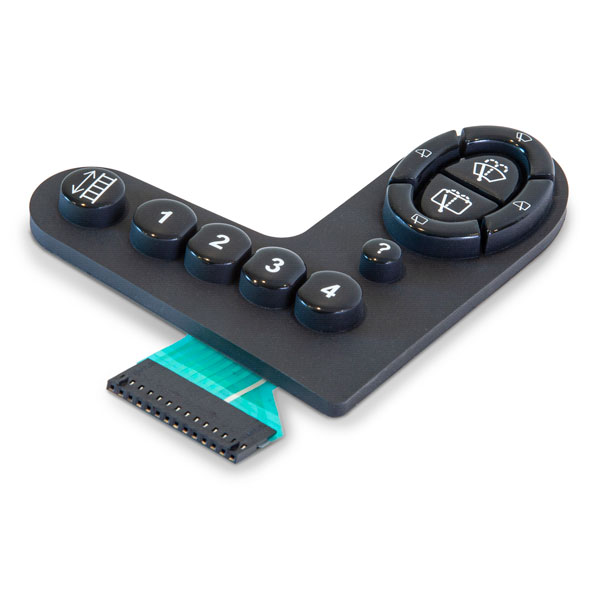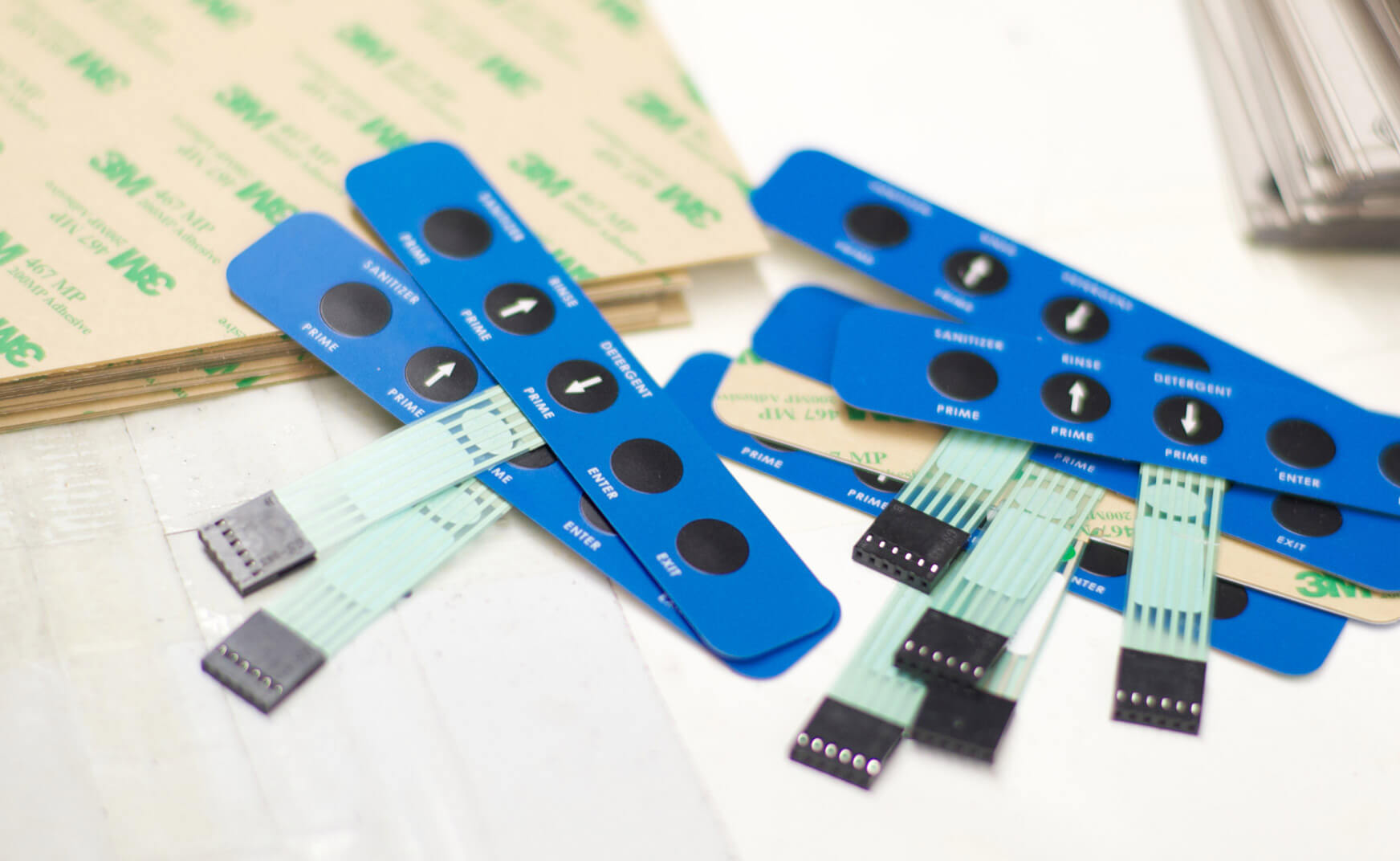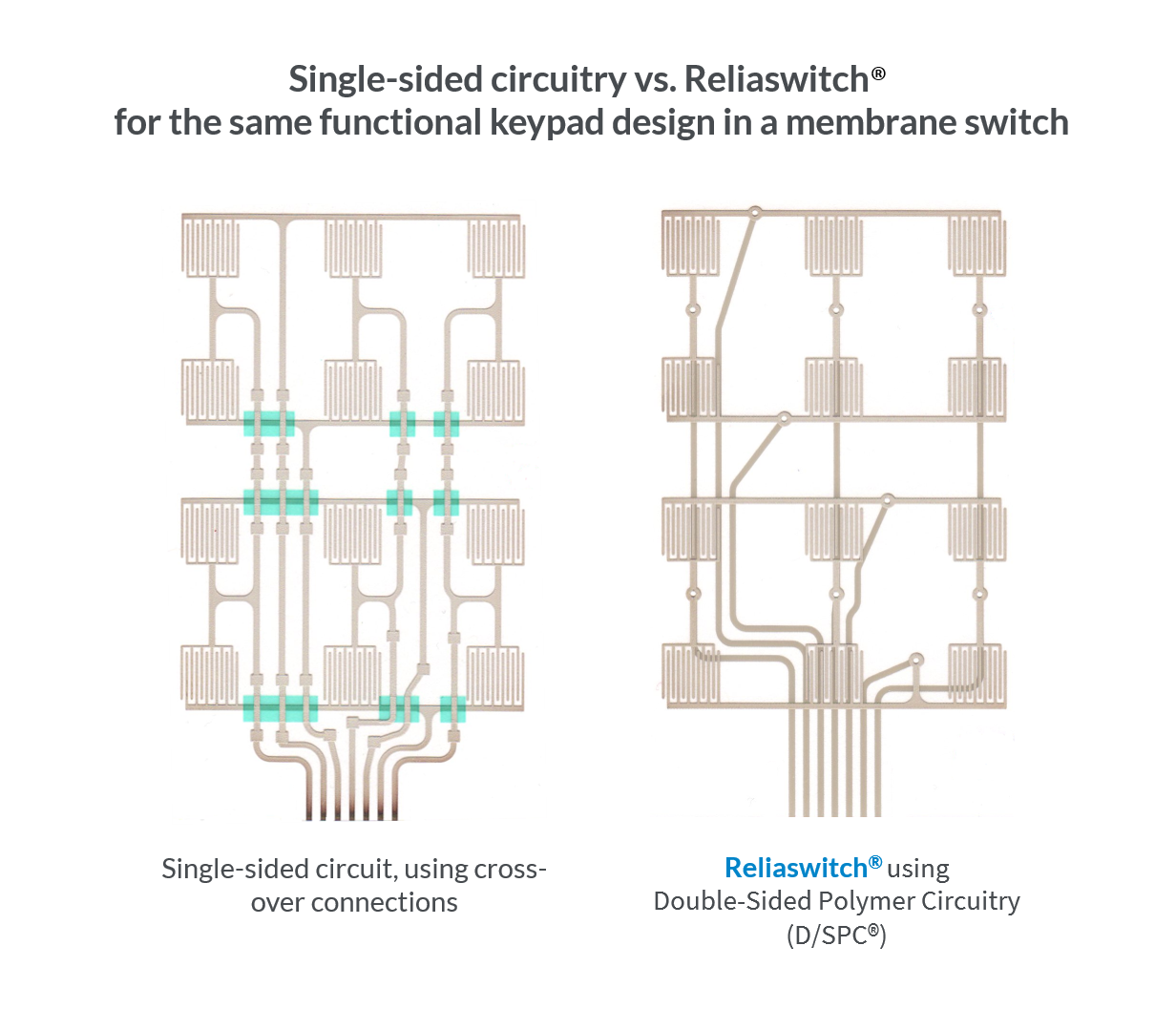See Why We’re a Trusted Membrane Switch Manufacturer
Recognizing the Importance of Membrane Switch in Modern Electronics and Their Applications
Membrane changes offer as a crucial component in contemporary electronic devices, providing a reliable user interface for individual communication. Their lightweight and adjustable nature makes them appropriate for an array of applications throughout varied industries. Comprehending their vital components and advantages can supply understandings right into their expanding relevance. As innovation remains to advance, the development of Membrane switches over questions about their future applications and design advancements. What exists in advance in this vibrant field?

What Are Membrane Switches?
Membrane buttons are vital elements in modern electronic devices, working as interface that assist in interaction between users and devices. These buttons include numerous layers, including a visuals overlay, an adhesive layer, and a circuit layer, every one of which interact to create a useful and resilient interface. The design enables for a level, low-profile remedy that can be personalized pertaining to size, form, and visual look, making them suitable for different applications, from customer electronics to medical tools. The tactile responses supplied by Membrane switches improves customer experience, while their resistance to dust and wetness makes them excellent for challenging environments. In addition, Membrane switches can integrate attributes such as backlighting and printed graphics, even more broadening their usability. Their adaptability and robustness make them a favored selection in sectors where reliability and ease of use are vital, inevitably adding to the smooth operation of modern-day electronic devices.
Trick Elements of Membrane Switches Over
While numerous parts contribute to the functionality of a membrane switch, three key layers play substantial roles in its design and operation. The leading layer, generally made from a resilient polymer, works as the interface for customer communication, often including published symbols and graphics. Under this is the spacer layer, which keeps the necessary range between the top layer and the circuit layer. This spacer layer guarantees that the switch activates just when pushed, stopping accidental inputs. Finally, the circuit layer contains conductive traces that finish the electric circuit when the leading layer is depressed. These traces can be made from numerous materials, including copper or silver. With each other, these parts produce a robust and dependable device that is compact and functional, appropriate for a vast array of digital applications, from home home appliances to medical tools. Recognizing these crucial components is essential for valuing the overall performance of Membrane buttons.
Advantages of Making Use Of Membrane Switches Over

Membrane Switch Manufacturing Refine
Understanding the Membrane switch production procedure reveals the detailed steps associated with creating these essential elements. The procedure usually begins with the style stage, where layouts and specs are developed utilizing specialized software. Following this, the graphic overlay is published on a flexible substrate, usually using high-resolution printing methods to assure clarity and precision.Next, the sticky layers are used, which serve to bond the different parts with each other. The circuit layers, made from conductive inks or materials, are after that published onto a separate substrate. These layers are very carefully straightened and laminated to produce a practical switch.After setting up, the buttons undergo evaluating to confirm capability and sturdiness. Quality assurance actions are implemented throughout the process to determine and fix any type of defects. Lastly, the finished Membrane buttons are packaged and prepared for circulation, ready to fulfill the needs of modern-day digital applications.
Applications of Membrane Switches Over in Various Industries
Membrane switches are progressively used across numerous industries, specifically in clinical equipment and customer electronic devices. In the clinical field, they provide trustworthy control user interfaces for devices that require accurate operation. In customer electronics, these switches boost customer communication by providing sleek and receptive user interfaces. Receptive Medical Devices Control
Numerous modern clinical gadgets utilize Membrane switches for structured procedure and enhanced customer communication. These switches provide a reliable, sturdy user interface for a selection of applications, including analysis devices, patient surveillance systems, and surgical tools. Their adjustable designs permit for certain layouts that can suit the special needs of medical care professionals, making certain user-friendly navigation and Visit Website effective access to vital functions. In addition, Membrane switches are immune to contaminants, making them ideal for sterile settings. The tactile feedback they supply can enhance customer confidence, minimizing the risk of errors throughout important clinical treatments. Overall, the assimilation of Membrane switches in clinical tools considerably adds to enhanced functional efficiency and person security in medical care setups.
Consumer Electronics Interfaces
In the domain name of customer electronics, Membrane switches play a crucial function in boosting user interfaces across a large range of tools. These buttons are indispensable to items such as push-button Learn More Here controls, microwaves, and video gaming consoles, giving a easy to use and effective user interface. Their design enables a seamless combination of graphics and performance, making it possible for suppliers to develop sleek, modern aesthetic appeals without endangering use. Membrane buttons are additionally recognized for their resilience, typically standing up to substantial usage and exposure to various environmental conditions. Additionally, they can incorporate attributes like backlighting and responsive responses, additional enhancing the individual experience. As customer needs for innovative yet instinctive user interfaces grow, Membrane switches proceed to be a crucial component beforehand electronic device functionality.
Style Considerations for Membrane Switches Over
Creating efficient Membrane changes needs careful attention to numerous aspects that influence both functionality and customer experience. One crucial consideration is the selection of materials, as they can impact longevity, responsive feedback, and visual charm. Selecting an ideal adhesive is necessary for ensuring long-term adhesion and resistance to ecological factors.In enhancement, the layout and design of the switch have to accommodate customer interaction, with button dimensions and spacing optimized for convenience of use. The unification of graphics and labeling must focus on clearness and visibility under numerous lights conditions.Consideration of electrical characteristics, such as actuation pressure and switch level of sensitivity, will improve the responsiveness of the Membrane switch. The style needs to accommodate making procedures to guarantee cost-effectiveness and timely manufacturing. Overall, a well-balanced layout enhances both the capability and the user experience of Membrane switches in contemporary electronic devices.

Future Patterns in Membrane Switch Modern Technology
As technology remains to develop, Membrane buttons are positioned to incorporate new improvements that will certainly boost their functionality and application in various fields. One considerable fad is the unification of adaptable and durable materials, which will enhance the lifespan and reliability of these switches. Enhanced surface textures and customizable graphics are also anticipated, permitting more instinctive individual interfaces.Moreover, the combination of wise innovation, such as touch-sensitive surfaces and haptic feedback, is expected to improve customer communication, making Membrane changes extra receptive and interesting. Additionally, advancements in printed electronic devices will certainly allow much more intricate wiring within thinner profiles, further increasing layout possibilities.Sustainability will also play an essential duty in future advancements, as producers discover eco-friendly products and production procedures. Generally, these patterns will certainly assure that Membrane switches remain vital and relevant in an interconnected and increasingly electronic world.
Regularly Asked Concerns
Just How Do Membrane Switches Over Contrast to Traditional Mechanical Buttons?
Membrane changes offer benefits over traditional mechanical buttons, consisting of lowered size, lighter weight, and boosted sturdiness. They typically supply a sealed surface, why not try these out boosting resistance to dust and dampness, making them excellent for diverse applications.
What Products Are Commonly Utilized in Membrane Switch Building?

Can Membrane Changes Withstand Extreme Environmental Issues?
Membrane buttons can withstand severe ecological conditions, relying on their design and products. Top quality buildings often include durability against temperature level fluctuations, humidity, and direct exposure to chemicals, making them ideal for numerous demanding applications throughout sectors.
How Lengthy Do Membrane Switches Over Usually Last Prior To Failing?
Membrane switches normally display a life-span ranging from 1 to 10 million actuations, depending upon aspects such as use regularity, environmental conditions, and producing high quality. Normal upkeep can extend their sturdiness and operational reliability significantly.
Are Membrane Changes Personalized for Details Applications?
Membrane buttons are indeed customizable for particular applications. They can be tailored in style, dimension, and functionality, permitting suppliers to meet special individual needs and boost product looks while keeping functional performance and longevity. Membrane buttons are vital elements in contemporary electronics, offering as customer interfaces that assist in communication between users and gadgets. The responsive comments offered by Membrane switches over improves individual experience, while their resistance to dust and dampness makes them suitable for challenging environments. The unification of graphics and labeling must focus on clearness and exposure under various lights conditions.Consideration of electrical characteristics, such as actuation pressure and switch sensitivity, will certainly enhance the responsiveness of the Membrane switch. Boosted surface textures and personalized graphics are also prepared for, enabling for more user-friendly user interfaces.Moreover, the assimilation of wise technology, such as touch-sensitive surface areas and haptic feedback, is anticipated to improve individual interaction, making Membrane switches a lot more responsive and appealing. Membrane switches deal benefits over conventional mechanical buttons, including minimized size, lighter weight, and enhanced durability.